Miami University
Coordinates: 39°30′43″N 84°44′05″W / 39.511905°N 84.734674°W
 | |
| Latin: Universitas Miamiensis | |
| Motto | Prodesse Quam Conspici |
|---|---|
Motto in English | To accomplish without being conspicuous[1] |
| Type | Public |
| Established | 1809 |
Parent institution | University System of Ohio |
| Endowment | $447 million (2016)[2] |
| President | Gregory Crawford[3] |
| Provost | Phyllis Callahan |
Administrative staff | 1,400 system-wide |
| Students | 24,505 system-wide |
| Undergraduates | 22,119 system-wide; 16,981 Oxford |
| Postgraduates | 2,386 system-wide |
| Location | Oxford, Ohio (main campus) |
| Campus | Rural, 2,138 acres (8 km2) |
| Colors |
Red and White[4] |
| Nickname | RedHawks |
Sporting affiliations |
NCAA Division I FBS Mid-American Conference National Collegiate Hockey Conference |
| Mascot | Swoop the RedHawk |
| Website |
www |
|
| |
Miami University (also referred to as Miami of Ohio or simply Miami) is a public research university on a 2,138-acre campus in Oxford, Ohio, 35 miles north of Cincinnati. The university was founded in 1809, although classes were not held until 1824. Miami University is the second-oldest university in Ohio, and the 10th oldest public (32nd overall) university in the United States.[5][6][7] Miami also has regional campuses in Hamilton, Middletown and West Chester, as well as the Dolibois European Center in Differdange, Luxembourg. The Carnegie Foundation classifies Miami University as a research university with a high research activity.[8][9] It is affiliated with the University System of Ohio.
Miami University is well known for its liberal arts education; it offers more than 120 undergraduate degree programs and over 60 graduate degree programs within its 8 schools and colleges in architecture, business, engineering, humanities and the sciences. In its 2017 edition, U.S. News & World Report ranked the university 79th among national universities and the 30th top public university in the United States.[10][11] Additionally, Miami University is ranked 2nd best national university (1st among public institutions) for undergraduate teaching.[12] Miami University is one of the original eight Public Ivy schools.[13][14]
Miami University has a long tradition of Greek life; five social Greek-letter organizations were founded at the university earning Miami the nickname "Mother of Fraternities". Today, Miami University hosts over 50 fraternity and sorority chapters, and approximately one-third of the undergraduate student population are members of the Greek community.[15] Miami is renowned for its campus' beauty, having been called "The most beautiful campus that ever there was" by Pulitzer Prize-winning poet Robert Frost. Additionally, Forbes ranked the city of Oxford first on its 2016 list of the best college towns in the United States.[16][17]
Miami's athletic teams compete in Division I of the National Collegiate Athletic Association (NCAA) and are collectively known as the Miami RedHawks. They compete in the Mid-American Conference (MAC) in all varsity sports except ice hockey, which competes in the National Collegiate Hockey Conference.
History
1800s
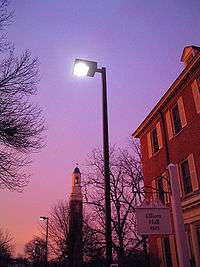
The foundations for Miami University were first laid by an Act of Congress signed by President George Washington, stating an academy should be Northwest of the Ohio River in the Miami Valley.[18] The land was within the Symmes Purchase; Judge John Cleves Symmes, the land's owner, purchased it from the government with the stipulation that he set aside land for an academy.[19] Congress granted one township to be in the District of Cincinnati to the Ohio General Assembly for the purposes of building a college, two days after Ohio was granted statehood in 1803; if no suitable location could be provided in the Symmes Purchase, Congress pledged to give federal lands to the legislature after a five-year period. The Ohio Legislature appointed three surveyors in August of the same year to search for a suitable township, and they selected a township off of Four Mile Creek.[19] The Legislature passed "An Act to Establish the Miami University" on February 2, 1809, and the state created a board of trustees; this is cited as the founding of Miami University.[19] The township originally granted to the university was known as the "College Township," and was renamed Oxford, Ohio, in 1810.
The University temporarily halted construction due to the War of 1812.[19] Cincinnati tried—and failed—to move Miami to the city in 1822 and to divert its income to a Cincinnati college.[19] Miami created a grammar school in 1818 to teach frontier youth, but it was disbanded after five years.[19] Robert Hamilton Bishop, a Presbyterian minister and professor of history, was appointed to be the first President of Miami University in 1824. The first day of classes at Miami was on November 1, 1824.[19] At its opening, there were 20 students and two faculty members in addition to Bishop.[19] The curriculum included Greek, Latin, Algebra, Geography, and Roman history; the University offered only a Bachelor of Arts. An "English Scientific Department" was started in 1825, which studied modern languages, applied mathematics, and political economy as training for more practical professions. It offered a certificate upon completion of coursework, not a diploma.[19]
Miami students purchased a printing press, and in 1827 published their first periodical, The Literary Focus. It promptly failed, but it laid the foundation for the weekly Literary Register. The Miami Student, founded in 1867, traces its foundation back to the Literary Register and claims to be the oldest college newspaper in the United States.[19] A theological department and a farmer's college were formed in 1829; the farmer's college was not an agricultural school, but a three-year education program for farm boys. William Holmes McGuffey joined the faculty in 1826, and began his work on the McGuffey Readers while in Oxford.[19] By 1834 the faculty had grown to seven professors and enrollment was at 234 students.[19] Eleven students were expelled in 1835, including one for firing a pistol at another student. McGuffey resigned and became the President of the Cincinnati College, where he urged parents not to send their children to Miami.[19]
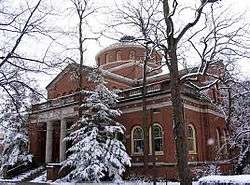
Alpha Delta Phi opened its chapter at Miami in 1833, making it the first fraternity chapter West of the Allegheny Mountains. In 1839, Beta Theta Pi was created; it was the first fraternity formed at Miami.[19]
In 1839 Old Miami reached its enrollment peak, with 250 students from 13 states; only Harvard, Yale, and Dartmouth were larger.[19] President Bishop resigned in 1840 due to escalating problems in the University, although he remained as a professor through 1844. He was replaced as President by George Junkin, former President of Lafayette College; Junkin resigned in 1844, having proved to be unpopular with students.[19] By 1847, enrollment had fallen to 137 students.
Students in 1848 participated in the "Snowball Rebellion". Defying the faculty's stance against fraternities, students packed Old Main, one of Miami's main classrooms and administrative buildings, with snow and reinforced the snow with chairs, benches and desks from the classroom.[19] Those who had participated in the rebellion were expelled from the school and Miami's student population was more than halved. By 1873, enrollment fell further to 87 students. The board of trustees closed the school in 1873, and leased the campus for a grammar school.[19] The period before its closing is referred to as "Old Miami."[19]
.jpg)
The university reopened in 1885, having paid all of its debts and repaired many of its buildings; there were 40 students in its first year. Enrollment remained under 100 students throughout the 1800s. Miami focused on aspects outside of the classics, including botany, physics, and geology departments.[19] In 1888, Miami began inter-collegiate football play in a game against the University of Cincinnati.[19] By the early 1900s, the state of Ohio pledged regular financial support for Miami University. Enrollment reached 207 students in 1902. The Ohio General Assembly passed the Sesse Bill in 1902, which mandated coeducation for all Ohio public schools. Miami lacked the rooms to fit all of the students expected the next year, and Miami made an arrangement with Oxford College, a women's college in the town, to rent rooms. Miami's first African-American student, Nelly Craig, graduated in 1905.[18] Hepburn Hall, built in 1905, was the first women's dorm at the college. By 1907, the enrollment at the University passed 700 students and women made up about a third of the student body.[19] Andrew Carnegie pledged $40,000 to help build a new library for the University.[19]
1900s
Enrollment in 1923 was at 1,500 students. The Oxford College for Women merged with Miami University in 1928.[19] By the early 1930s, enrollment had reached 2,200 students. The conservative environment found on campus called for little change during the problems of the Great Depression, and only about 10 percent of students in the 1930s were on government subsidies.[19] During World War II, Miami changed its curriculum to include "war emergency courses" and a Navy Training School took up residence on campus. During wartime in 1943, the population of the University became majority women.[19] Due to the G.I. Bill, tuition for veterans decreased; the enrollment at Miami jumped from 2,200 to 4,100 students. Temporary lodges were constructed to accommodate the number of students. By 1952, the student body had grown to 5,000.[19]

In 1954, Miami created a common curriculum for all students to complete to have a base for their other subjects. By 1964, enrollment reached nearly 15,000.[19] To accommodate the growing number of students, Miami University started a regional branch of the University at Middletown, Ohio, in 1966 and Hamilton, Ohio, in 1968.[19] Miami founded a Luxembourg branch, today called the Miami University Dolibois European Center, in 1968; students live with Luxembourgian families, and study under Miami professors.[19] Miami experimented with a trimester plan in 1965, but it ultimately failed and the university reverted to a quarter system. In 1974, The Western College for Women in Oxford, was sold to Miami; and President Shriver oversaw the creation of the well-respected and innovative Interdisciplinary Studies Program known as the Western College Program.[19] The program was merged into the College of Arts & Science in 2007.[20] The newest regional campus, the Miami University Voice of America Learning Center opened in 2009.
Campus
Miami University's main campus is in Oxford, Ohio; the city is in the Miami Valley in Southwestern Ohio. Development of the campus began in 1818 with a multipurpose building called Franklin Hall; Elliott Hall, built in 1825, is Miami's oldest residence hall.[19][21] Miami is renowned for its campus beauty, having been called "The most beautiful campus that ever there was" by Pulitzer Prize-winning poet Robert Frost, a friend of then Miami artist-in-residence Percy McKaye, a poet. Miami has added campus buildings, such as the Farmer School of Business Building, in the style characteristic of Georgian Revival architecture, with all buildings built three stories or less, or "to human scale". Today, the area of Miami's Oxford campus consists of 2,138 acres (8 km2).[21][22]
Oxford, Ohio is a college town, with over 70.0% of the residents attending college or graduate school.[23] Forbes ranked the city of Oxford first on its 2016 list of the best college towns in the United States.[16] All first and second year students are required to live on-campus and all dorms are three stories or less.[24] Miami University’s dining options includes about 30 dining destinations on campus, including Maple Street Station and Garden Commons, each with multiple dining options. Miami’s dining services have won 52 awards since 2004.[25] Miami University also has a Recreational Sports Center. The center has three basketball courts, an Olympic-sized pool and diving well, outdoor pursuit center, rock-climbing center, fitness room, large exercise classrooms and a weight room.[26]
The Hefner Museum of Natural History, in Upham Hall, features displays of many hoofed animals and other animal mounts, shells, corals and sponges, skeletons and fossils.[27]
Historic landmarks
- William Holmes McGuffey Museum, a National Historic Landmark
- Zachariah Price Dewitt Cabin, listed on the National Register of Historic Places
- Elliott and Stoddard Halls, oldest dormitories in use in Ohio
- Langstroth Cottage, a National Historic Landmark
- Old Manse (home of the University Honors Program) Presbyterian Parsonage, East High Street, listed in the Historic American Buildings Survey
- Simpson-Shade Guest House, listed in the Historic American Buildings Survey
- Lewis Place, home of Miami presidents
King Library
King Library was originally known as the King Undergraduate Library when the south section was completed in 1966. When the north section was completed in 1972, the word "undergraduate" was dropped from its name. Before King Library was built, Alumni Library was the main university library. When King Library was completed in 1972, Alumni Library was changed to Alumni Hall.
Academics
Rankings
| University rankings | |
|---|---|
| National | |
| Forbes[28] | 155 |
| U.S. News & World Report[29] | 96 |
| Washington Monthly[30] | 133[31] |
| Global | |
| ARWU[32] | Does not appear. |
| QS[33] | 701. |
| Times[34] | 601-800 |

U.S. News & World Report in its 2017 rankings ranked the university's undergraduate program 79th among national universities, and 30th among public universities. U.S. News also ranked the university fifth for best undergraduate teaching at national public universities.[35] Kiplinger’s Personal Finance magazine listed Miami as one the "100 Best Values in Public Colleges" for 2015 ranking Miami 55th nationally. Miami has appeared on the list since it was first published in 1998. Forbes ranked Miami 155th in the United States among all colleges and universities and listed it as one of "America's Best College Buys".[36] In March 2014, BusinessWeek ranked the undergraduate business program for the Farmer School of Business at 23rd among all U.S. undergraduate business schools and was ranked 8th among public schools.[37] Entrepreneur ranked Miami's Institute for Entrepreneurship in its top ten undergraduate programs in the nation.[38] The Wall Street Journal ranked Miami 22nd among state schools for bringing students directly from undergraduate studies into top graduate programs.[39] The Journal also ranked Miami's accelerated MBA program ninth globally.[40] Miami's accountancy program received high marks from the Public Accounting Report's rankings of accountancy programs; its undergraduate and graduate programs ranked 17th and 20th respectively.[41] In 1985, Richard Moll wrote a book about America's premier public universities where he describes Miami as one of America's original eight "Public Ivies", along with the University of California, University of Michigan, University of Virginia, College of William and Mary, University of Texas, University of Vermont, and the University of North Carolina.[42]
Miami also receives high marks for its beautiful campus. Newsweek rated Miami No. 19, in its 2012 list of Most Beautiful Schools and poet Robert Frost described it as "The most beautiful campus that ever there was."[43]
Undergraduates
Miami is a large, primarily residential teaching university with a focus on undergraduate studies.[44] The university offers more than 100 majors,[45] 48 minors,[46] and 11 co-majors.
Miami University has seven academic divisions:
- College of Arts and Science
- Farmer School of Business
- College of Creative Arts
- College of Education, Health, and Society
- College of Engineering and Computing
- Graduate School
- College of Liberal Arts and Applied Science (Miami Regionals)
The College of Arts and Science (or CAS) is the oldest and largest college at Miami, with over 75% of the undergraduate student body enrollment. The CAS offers more than 60 majors covering a broad range of areas of study. The curriculum emphasizes creativity, research, and global perspectives.[47] Ten of the 14 doctoral degrees offered by Miami are provided through the College of Arts & Science.[48]
Miami's Farmer School of Business is a nationally recognized school of business that offers eight majors. The school also offers graduate MBA, accountancy, and economics degrees. The Farmer School of Business (or FSB) is housed in a 210,000-square-foot (20,000 m2) state-of-the-art, LEED-certified building.[50] The FSB building, opened for classes in 2009, was designed by leading revivalist architect Robert A.M. Stern.
The College of Engineering and Computing (formerly School of Engineering & Computing (formerly Applied Science)) offers 10 accredited majors at the Oxford campus,[51] and moved into a new $22 million engineering building in 2007.[52] The school also offers four master's degrees in Computer Science, Chemical Engineering, Computational Electrical and Computer Engineering and Mechanical Engineering.[53]
The School of Education, Health & Society (formerly Education and Allied Professions) offers 26 undergraduate degrees[54] spanning from areas of teacher education, kinesiology, and health to educational psychology, family studies, and social work.[55] As of fall 2009, nearly 3,500 full-time and part-time undergraduates were enrolled in the school.[54]
Miami's School of Creative Arts (formerly Fine Arts) has four departments: architecture and interior design, music, theatre, and art. Each department has its own admission requirements, either a portfolio or audition, which are separate from the standard admissions requirements for the University. Art majors choose a concentration in areas such as ceramics, metals, photography, printmaking, sculpture, graphic design, and interior design. Music majors specify either music performance or music education, and choose their focus, whether instrumental or vocal.[56][57]
Graduate students
Miami offers master's degrees in more than 50 areas of study and doctoral degrees in 14, the largest of which are doctoral degrees in psychology. To enroll in graduate courses, students must first be accepted into the Graduate School, and then into the department through which the degree is offered.[58] Although tuition for the Graduate School is roughly the same as for an undergraduate degree, most of the graduate programs offer graduate assistantships as well as tuition waivers.
Organizations and clubs
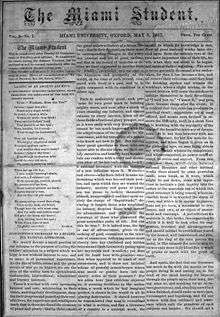
Aside from the university's student newspaper (see below), the university's oldest and longest-running student organization is the Miami University Men's Glee Club, founded in 1907.[59] It is estimated to be the 16th oldest Glee Club in the nation and is one of the largest of its kind. In 2018, Miami's mock trial program won its second national American Mock Trial Association championship title, beating Yale in the final round, leading them to be ranked first out of over 700 university teams across the country for the upcoming 2018-19 season.[60][61]
Media
Miami has a variety of media outlets. The student-run newspaper, The Miami Student, claims to have been founded in 1826, which would make it the oldest university newspaper in the United States. However, the first issue is dated May 1867, and the paper refers to itself as "the oldest college newspaper west of the Alleghenies."[62] The undergraduate literature and art magazine, Inklings, is available in print and online.[63] RedHawk Radio (WMSR) is Miami's only student radio station.[64] Miami University Television (MUTV) is available on cable in Oxford, Ohio.[65] UP Magazine is Miami's student-run fashion magazine that publishes an issue each semester and also maintains a blog.[66]
Student life
Student body
| Undergraduate | Graduate | U.S. Census[68] | |
|---|---|---|---|
| Non-Hispanic White | 73% | 75% | 60.7% |
| Black | 4% | 5% | 13.4% |
| Asian | 2% | 3% | 5.8% |
| Hispanic (of any race) | 4% | 5% | 18.1% |
| Other races/ethnicities | 4% | 3% | 2% |
| International | 13% | 9% | (N/A) |
As of 2017, Miami University has a total enrollment of 24,424 admitted students. The Oxford campus encompasses 19,452 students, of which 17,147 are at the undergraduate and 2,305 at the graduates and professional.[69][70][71] Although 40.5% of students come from Ohio, offers of first-year admission for Fall 2017 included students from all 50 U.S. states, the District of Columbia and abroad. Miami University encompasses 3,056 international students from 85 countries. Of the regularly enrolled international students, the most represented countries/regions are China, India, Vietnam and South Korea, in that order.[72] With a gender distribution of 49% male students and 51% female students, Miami University's gender disparity between men and women is far below the national average, making it one of the most equally balanced undergraduate institutions in the United States.[73] Ethnic diversity at Miami University is low among public universities in the United States.[74] The student body at Miami University remains predominantly white, despite efforts to recruit more minority students. Miami University ranked 95th out of 100 national universities for academics by diversity and as of Fall 2016, it had the lowest percentage of domestic students of color among all five major public universities in Ohio.[75]
Student-run organizations
For the 2017-18 academic year, Miami had over 600 registered student organizations. These clubs and organizations run the gamut from varsity sports clubs to professional fraternities, from political and religious groups to fashion, theatre and LGBTQ+ organizations. The university recognizes the Associated Student Government (ASG) that represents student interests to faculty, administrators, and the Ohio Legislature. It is the official student government of Miami University.[76] It has an executive branch run by a student president and 14 members of the executive cabinet who work with administrators in all areas of student life as well as academics, a legislative branch made up of 50 senators who voice student concerns, write and vote on legislation on a weekly basis and the judicial branch, made up of 17 undergraduate students who compose the student court that hears cases involving violations of the student code, and ensures that students are aware of their legal rights.[77]
Miami University Men's Glee Club
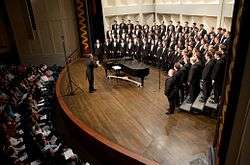
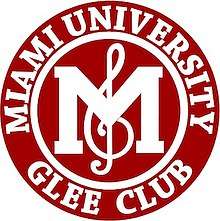
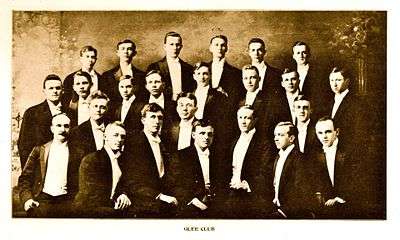
Aside from the university's student newspaper, the university's oldest and longest-running academic student organization is the Miami University Men's Glee Club.[59] Founded in 1907 by professor Robert H. Burke, composer of Miami's fight song and alma mater, the glee club is among the oldest and largest groups of its kind in the nation.[78] It is composed of over 100 singers selected by audition from all academic disciplines. The group's repertoire ranges from Gregorian Chant and Renaissance motets to folksongs, popular music, and spirituals. The Glee Club performs three concerts, in fall, winter, and spring each year at Miami's Hall Auditorium, constructed in 1907-8. The fall semester concerts are paired with Miami's large mixed choir, Collegiate Chorale. In addition to these, the Glee Club will often perform at Miami University events, local churches, and high schools in the greater Ohio area.
The Glee Club has also performed with major symphony orchestras at a regional and national level; most frequently with the Cincinnati Symphony Orchestra. Throughout its history, the Glee Club has worked with renowned composers, conductors and singers singers such as Morten Lauridsen, Martina Arroyo, Max Rudolf, Thomas Schippers, Paul Salamunovich and more recently A.R. Rahman.[78][79] In 2014, the Glee Club performed a Memorial Day service at the Normandy American Cemetery and Memorial, as part of its biannual international tour, and later won the First European Prize with Great Distinction at the Concours Europeen de Chant Choral 2014 (European Choir Competition).[80]
The Glee Club also hosts one men’s a cappella singing group, The Cheezies. This group consists of approximately 15 members auditioned from the Glee Club.
Residential life
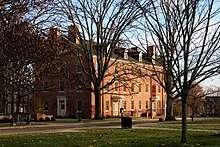
Residential life is a primary characteristic of the undergraduate education at Miami University and is embedded in the University's Mission Statement. Miami University requires first and second year students to live on campus.[81] Elliott and Stoddard Halls are two of the oldest remaining buildings on campus today. Built in 1828 and 1835 respectively, they continue to be used as dormitories and are considered two of the most prestigious dorms to live in.[82] They are also listed on the National Register of Historic Places.[83] The campus has a total of 46 residence halls, the newest of which opened in 2018.[84][85] The residence halls are organized into 8 quads throughout campus:[86]
- Academic Quad: Bishop Hall, Elliott Hall, Ogden Hall, Stoddard Hall, Wells Hall.
- Central Quad: Hamilton Hall, MacCracken Hall, Maplestreet Station, Minnich Hall, Richard Hall, Scott Hall.
- East Quad: Collins Hall, Dennison Hall, Dorsey Hall, McBride Hall, Miami Inn, Symmes Hall, Wilson Hall.
- Heritage Commons: Blanchard House, Fisher Hall, Logan Lodge, Pines Lodge, Reid Hall, Tallawanda Hall.
- North Quad: Brandon Hall, Flower Hall, Hahne Hall, Hepburn Hall, McFarland Hall, Presidents Hall (opened in 2018), Swing Hall (demolished in 2018), Withrow Hall (opened in 2018).
- South Quad: Anderson Hall, Dodds Hall, Emerson Hall, Etheridge Hall, Morris Hall, Porter Hall, Stanton Hall, Tappan Hall.
- Western Campus: Beechwoods Hall, Clawson Hall, Havighurst Hall, Hillcrest Hall, Mary Lyon Hall (demolished in 2016), McKee Hall, Peabody Hall, Stonebridge Hall, Thomson Hall.
Within its existing residential life programs, Miami offers students the option of choosing from 35 theme-based living learning communities (LLCs). All first-year residential halls on campus participate in the LLC program to create bonds among students based on their field of study and shared interests.[87][88] In an LLC, students are co-enrolled into one or more classes, which further support student's transition into the university's liberal arts education. Smaller groups of students may also create their second year LLC to further their learning together.
Each residence hall has various residence assistants (RAs) who are full-time enrolled students that assist the Office of Residence Life to promote community engagement, enforce hall and university policies, submit residence hall reports, and promote academic success. Residence halls also have representatives that participate collectively in the Residence Hall Association and the student senate.[89]
Greek life
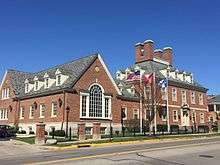
Miami has 21 active sorority and 30 active fraternity chapters. Miami is nicknamed the Mother of Fraternities for the number of fraternities that started on its campus: Beta Theta Pi (1839), Phi Delta Theta (1848), Sigma Chi (1855), and Phi Kappa Tau (1906). However, Alpha Delta Phi (1832) was the first fraternity on campus.[90] Delta Zeta, founded in 1902, is the only sorority alpha chapter on campus.[90] The Miami Triad refers to the first three fraternities founded at Miami: Beta Theta Pi, Phi Delta Theta, and Sigma Chi. The Triad is sometimes celebrated with parties at other universities such as the University of Kansas.[91] As of Fall 2017, there are 2,556 sorority members and 1,544 fraternity members.[92] Miami University's office of Greek affairs was endowed with a $1 million gift from Cliff Alexander, a Miami University alumnus and a member of Sigma Nu; Miami believes this gift will support the Greek program well into the next century.[93] Miami hosts about 50 different fraternities and sororities governed by three different student governing councils. Miami's fraternities and sororities hold many philanthropy events and community fundraisers.[94] In the 2017 Fall Semester, the Greek Community recorded 11,847 service hours and raised $96,839 for philanthropic causes.[95]
A spate of sorority sanctions in the 2009–10 school year reached national news for the actions that were involved. Sorority members of Miami's Alpha Xi Delta chapter and their dates at a formal held at the National Underground Railroad Freedom Center urinated throughout the venue, swore at staff, and attempted to steal drinks from the bar; one other incident involving the Pi Beta Phi chapter at Miami involved similar behavior.[96][97] Former University President David Hodge called the behavior "deeply troubling" and "embarrassing", and vowed "we are determined to live up to our values" in response to the incidents.[98]
More recently, Miami's Greek system has come under fire for numerous hazing and alcohol violations. Multiple Greek organizations have been suspended in recent years including: Alpha Xi Delta, Beta Theta Pi (Alpha Chapter), Kappa Sigma, Phi Kappa Psi, Sigma Alpha Epsilon, Phi Kappa Tau (Alpha Chapter), Pi Kappa Phi, Pi Beta Phi, Sigma Nu, and Zeta Beta Tau. In late 2015 three fraternities (Sigma Nu, Phi Kappa Psi and Kappa Sigma) were evicted from Miami University. Among the violations was encouraging pledges to drink 100 beers and pose for inappropriate social media pictures. In other instances, pledges were subjected to hours long, early morning workouts and forbidden to shower or shave.[99]
 Epsilon Pi Chapter house of Alpha Sigma Phi
Epsilon Pi Chapter house of Alpha Sigma Phi Alpha Chapter house of Phi Delta Theta
Alpha Chapter house of Phi Delta Theta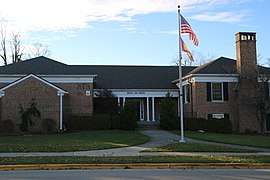 Gamma Upsilon Chapter house of Delta Tau Delta
Gamma Upsilon Chapter house of Delta Tau Delta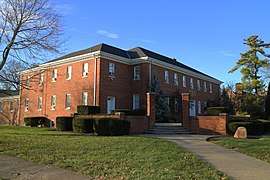 Zeta-Upsilon Zeta Chapter house of Lambda Chi Alpha
Zeta-Upsilon Zeta Chapter house of Lambda Chi Alpha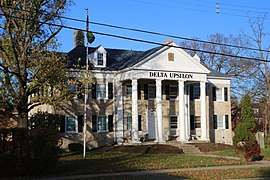 Miami Chapter house of Delta Upsilon
Miami Chapter house of Delta Upsilon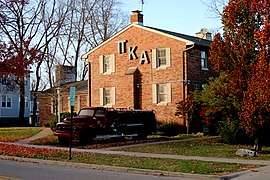 Delta Gamma Chapter house of Pi Kappa Alpha
Delta Gamma Chapter house of Pi Kappa Alpha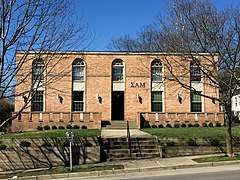 Mu Psi Chapter house of Sigma Alpha Mu fraternity
Mu Psi Chapter house of Sigma Alpha Mu fraternity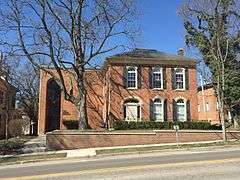 Delta Xi Chapter house of Tau Kappa Epsilon
Delta Xi Chapter house of Tau Kappa Epsilon Theta Upsilon Chapter house of Kappa Sigma (currently suspended)
Theta Upsilon Chapter house of Kappa Sigma (currently suspended)
Athletics
Miami's National Collegiate Athletic Association (NCAA) Division I sports teams are called the RedHawks; the program offers 18 varsity sports for men and women. They compete in the Mid-American Conference (MAC) in all varsity sports except ice hockey, which competes in the National Collegiate Hockey Conference.
Miami's athletic teams were called The Miami Boys, The Big Reds, The Reds, or The Red and Whites until 1928 when Miami Publicity Director R.J. McGinnis is credited with coining the term Redskins. The athletic teams were known as the Redskins up through 1997 when the Oklahoma-based Miami tribe withdrew its support for the nickname; the board of trustees voted to change the nickname to the RedHawks.[100] Miami is nicknamed the "Cradle of Coaches" for the coaches that have trained through its football program and in early 2012 Miami trademarked the phrase.[101] The athletic director is David Sayler, who was hired to the position in December 2012.[102]
Football
.jpg)
Miami is known as the Cradle of Coaches for its quality football coaches that leave its program; Ben Roethlisberger, a quarterback from Miami, has gone on to be a two-time Super Bowl winning quarterback for the Pittsburgh Steelers. John Harbaugh, a defensive back from Miami, coached the Baltimore Ravens to a victory in Super Bowl XLVII.
Miami's football team plays in Yager Stadium, a 24,286-seat football stadium on campus; they formerly played in the now demolished Miami Field. The coach is Chuck Martin, who was named head coach December 3, 2013. Previously, Martin was the offensive coordinator at The University of Notre Dame. The RedHawks compete each year against the Cincinnati Bearcats for the Victory Bell, a tradition that dates back to 1888.
Basketball
The Miami men's basketball team has appeared in 16 NCAA basketball championship tournaments, reaching the Sweet Sixteen four times, most recently in 1999. Notable former student-athletes have included Randy Ayers, Ron Harper, Wally Szczerbiak, and Wayne Embry.
The team competes in Millett Hall and was coached by Charlie Coles, a 1965 graduate of Miami, for 16 seasons until he retired on March 5, 2012. His replacement is John Cooper.
Men's Ice hockey

Miami's men's varsity ice hockey team started in 1978 coached by Steve Cady.[103] The RedHawks made the NCAA national title game in 2009, but lost in overtime to Boston University after leading much of the game.[104] The head coach is Enrico Blasi, who has a total record of 262-169-46 after 12 seasons.[105] Since the Mid-American Conference does not include Division I men's ice hockey, Miami competed in the Central Collegiate Hockey Association (CCHA) through the 2012-2013 season. It was one of three schools from the MAC in the CCHA along with Bowling Green State University and Western Michigan University. However, starting with the 2013-2014 season, Miami began competing in the National Collegiate Hockey Conference, which will also include Colorado College, University of Denver, University of North Dakota, University of Minnesota Duluth, University of Nebraska at Omaha, Western Michigan University, and St. Cloud State University.
The men's ice hockey team plays at the Goggin Ice Center. The center has two rinks: a practice rink and Steve Cady Arena, which is used by the hockey team. The arena has a seating capacity of 3,200, and it replaced the Goggin Ice Arena in 2006.
Synchronized skating
Miami's synchronized skating team began in August 1977 as a "Precision Skating Club" at Goggin Ice Center.[106] The program achieved varsity status by 1996.[107] The Miami University senior synchronized skating team are the 1999, 2006, and 2009 U.S. national champions.[107][108][109] Miami won a silver medal at the 2007 World Championships, the first medal ever won by Team USA for synchronized skating.[110] The collegiate-level team has won 18 national titles; Miami created a junior-varsity level team beneath the senior level.[107] Vicki Korn, after serving as the coach of Miami's program for 25 years, announced her retirement in May 2009.[107] The head coach is Carla DeGirolamo. A 2003 graduate of Miami, Carla skated with the program all four of her undergraduate years and then spent seven seasons as an assistant coach.
Alumni
Miami alumni are active through various organizations and events such as Alumni Weekend.[111] The Alumni Association has active chapters in over 50 cities.[112] A number of Miami alumni have made significant contributions in the fields of government, law, science, academia, business, arts, journalism, and athletics, among others.
Miami University is one of four schools that have graduated both a U.S. President and a Super Bowl winning quarterback.[113] Benjamin Harrison, the 23rd President of the United States, graduated from Miami in 1852.[114] Charles Anderson, the 27th Governor of Ohio, graduated from Miami in 1833.[115] Chung Un-chan, the previous Prime Minister of South Korea, received his master's degree from Miami in economics in 1972.[116] Other politicians include U.S. Senator Maria Cantwell of Washington, U.S. House of Representatives Speaker Paul Ryan of Wisconsin, and U.S. Representative Susan Brooks of Indiana.[117][118] Rita Dove, a Pulitzer Prize winner and the first African-American United States Poet Laureate, graduated summa cum laude from Miami.[119] Other prominent alumni in business include: Marne Levine, COO of Instagram, C. Michael Armstrong, former chairman & CEO of AT&T, former chairman/CEO of Hughes Aircraft Co. and former chairman of the President's Export Council, and Richard T. Farmer, founder and CEO emeritus of Cintas. Chris Rose is a studio host with the MLB Network and NFL Network. John Harbaugh is the head coach of the Baltimore Ravens. Paul Brown, the partial founder of both the Cleveland Browns and the Cincinnati Bengals and a head coach for both teams graduated from the class of 1930.[120] Bo Schembechler was a Miami graduate and coached at Miami before moving to coach the Michigan Wolverines for twenty years.[120] Miami alumni that play in professional sports leagues include Dan Boyle of the NHL, Andy Greene of the NHL, Ryan Jones of the NHL, Alec Martinez of the NHL, Reilly Smith of the NHL, Jeff Zatkoff of the NHL, John Ely of the MLB, Adam Eaton of the MLB, golfer Brad Adamonis, Milt Stegall (Cincinnati Bengals and Winnipeg Blue Bombers), 2002 NBA All-Star Wally Szczerbiak,[121] and NFL players Brandon Brooks, Quinten Rollins, Zac Dysert, and two-time Super Bowl-winning quarterback Ben Roethlisberger.[122]
 23rd President of the United States Benjamin Harrison
23rd President of the United States Benjamin Harrison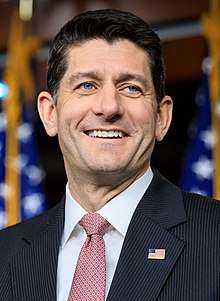 54th Speaker of the US House of Representatives Paul Ryan
54th Speaker of the US House of Representatives Paul Ryan United States Senator from Washington Maria Cantwell
United States Senator from Washington Maria Cantwell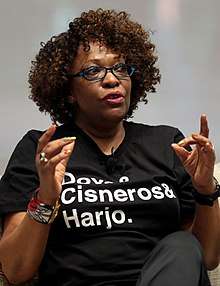 Pulitzer-prize winner American poet and essayist Rita Dove
Pulitzer-prize winner American poet and essayist Rita Dove American animation writer Mark Hentemann
American animation writer Mark Hentemann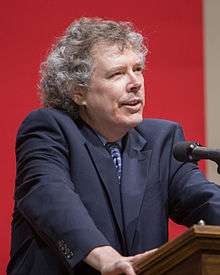 American author and political scientist Darrell M. West
American author and political scientist Darrell M. West Chief operating officer of Instagram Marne Levine
Chief operating officer of Instagram Marne Levine_2017.jpg) Philadelphia Eagles football player Brandon Brooks
Philadelphia Eagles football player Brandon Brooks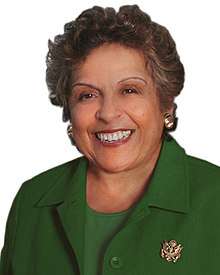 Former U.S. Secretary of Health and Human Services Donna Shalala
Former U.S. Secretary of Health and Human Services Donna Shalala American architect Greg Lynn
American architect Greg LynnCropped.jpg) Former Prime Minister of South Korea Chung Un-chan
Former Prime Minister of South Korea Chung Un-chan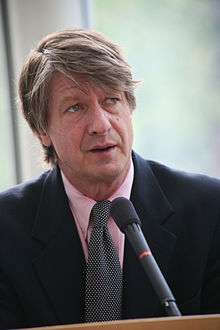 American journalist P. J. O'Rourke
American journalist P. J. O'Rourke
See also
References
- ↑ http://www.miamialum.org/s/916/16/interior.aspx?pgid=405&gid=1
- ↑ "U.S. and Canadian Institutions Listed by Fiscal Year (FY) 2016 Endowment Market Value and Change* in Endowment Market Value from FY2015 to FY2016" (PDF). NACUBO. February 2017. Archived from the original (PDF) on 2017-02-15. Retrieved 23 March 2017.
- ↑ "Gregory Crawford chosen as Miami University's 22nd president". Retrieved 24 August 2016.
- ↑ "Colors". Archived from the original on 25 July 2015. Retrieved 30 July 2015.
- ↑ "Oldest Universities In The US". Ranker. Retrieved 2018-02-04.
- ↑ Public: William and Mary (1693) University of Delaware (1743) Rutgers (1766) College of Charleston (1770) UNC-Chapel Hill (1789) University of Vermont (1791) University of Tennessee (1794) West Point (1802) Ohio University (1804) Miami University (1809)
- ↑ Overall Harvard (1636) William and Mary (1693) St. John’s (1696) Yale (1701) University of Pennsylvania (1740) Moravian College (1742) University of Delaware (1743) Princeton (1746) Washington and Lee University (1749) Columbia University (1754) Brown (1764) Rutgers (1766) Dartmouth (1769) College of Charleston (1770) Salem College (1772) Dickinson College (1773) Hampden-Sydney College (1775) Transylvania University (1780) Washington and Jefferson College (1781) Washington College (1782) Franklin and Marshall College (1787) Pitt (1787) Georgetown (1789) UNC-Chapel Hill (1789) University of Vermont (1791) Williams College (1793) Bowdoin College (1794) University of Tennessee (1794) Union College (1795) West Point (1802) Ohio University (1804) Miami University (1809)
- ↑ "Carnegie Classification of Institutions of Higher Education". Carnegie Classifications. Retrieved 23 March 2017.
- ↑ "Carnegie Classification". Miami University. Retrieved 23 March 2017.
- ↑ "2016 US News & World Report Rankings".
- ↑ "National University Rankings". U.S. News & World Report. Archived from the original on 2011-05-21.
- ↑ "2016 US News & World Report Rankings for Best Undergraduate Teaching".
- ↑ Moll, Richard (1985). Public Ivys: A Guide to America's best public undergraduate colleges and universities. ISBN 9780670582051.
- ↑ Greene, Howard; Greene, Matthew (2001). The Public Ivies: America's Flagship Public Universities. Collins Reference. ISBN 9780060934590.
- ↑ "Miami Traditions". Miami University. Retrieved 23 March 2017.
- 1 2 Strauss, Karsten (13 December 2016). "The Best And Worst College Towns In The U.S." Forbes. Retrieved 23 March 2017.
- ↑ "2016's Best College Towns & Cities in America". WalletHub. Retrieved 23 March 2017.
- 1 2 "Miami University: Documents and Policies: General Bulletin". Miami University. Retrieved 2010-02-28.
- 1 2 3 4 5 6 7 8 9 10 11 12 13 14 15 16 17 18 19 20 21 22 23 24 25 26 27 28 29 30 31 32 Havighurst, Walter (1984). The Miami Years. New York: G.P. Putnam and Sons. Retrieved 2010-02-28.
- ↑ "FAQ :: Western Program". Miami University. Retrieved 2010-02-28.
- 1 2 "Walking Tour of Miami University". Miami University. Archived from the original on 2016-07-31. Retrieved 2016-07-27.
- ↑ "Miami University". Princeton Review. Retrieved 2010-03-03.
- ↑ "Oxford city, Ohio - DP-2. Profile of Selected Social Characteristics: 2000". U.S. Census. Retrieved 2010-02-26.
- ↑ "Mother of Fraternities Milestone: Greek Life's 175th Anniversary". Miami University. Retrieved 2010-02-26.
- ↑ "Dining Services". Retrieved 30 July 2015.
- ↑ "Miami Recreation - Miami University". Retrieved 30 July 2015.
- ↑ "Hefner Museum of Natural History". Miami University. Retrieved 5 October 2017.
- ↑ "America's Top Colleges". Forbes. July 5, 2016.
- ↑ "Best Colleges 2017: National Universities Rankings". U.S. News & World Report. September 12, 2016.
- ↑ "2016 Rankings - National Universities". Washington Monthly. Retrieved September 6, 2016.
- ↑ "2014 National Universities Rankings". Washington Monthly. n.d. Archived from the original on August 28, 2014. Retrieved May 26, 2015.
- ↑ "Academic Ranking of World Universities 2017". Shanghai Ranking Consultancy. 2017. Retrieved August 29, 2017.
- ↑ "QS World University Rankings® 2018". Quacquarelli Symonds Limited. 2017. Retrieved 25 July 2017.
- ↑ "World University Rankings 2016-17". THE Education Ltd. Retrieved September 21, 2016.
- ↑ "Best Undergraduate Teaching". U.S. News & World Report. Retrieved 2010-08-18.
- ↑ "America's Top Colleges". Forbes. 2012-08-01. Retrieved 2012-08-28.
- ↑ "The Complete Ranking Best Undergraduate Business Schools 2014". Business Week. Archived from the original on 2015-02-02.
- ↑ "Top 25 Undergraduate Entrepreneurial Colleges for 2009". Entrepreneur. Retrieved 2014-09-16.
- ↑ Bernstein, Elizabeth. "How State Schools Did" (PDF). The Wall Street Journal. Retrieved 2009-11-06.
- ↑ "One-Year M.B.A. Programs". The Wall Street Journal. 2009-09-16. Retrieved 2009-12-30.
- ↑ "Miami U. scores high marks for accounting program". Accounting Today. 2015-12-14.
- ↑ Greene, Howard and Greene, Matthew. The Public Ivies: America's Flagship Public Universities (New York: HarperCollins, 2001). ISBN 0-06-093459-X.
- ↑ "College Rankings 2012: Most Beautiful Schools (Photos) - Newsweek and The Daily Beast". Thedailybeast.com. Retrieved 2012-10-12.
- ↑ "Carnegie Classifications - Miami University-Oxford". Carnegie Foundation for the Advancement of Teaching. Retrieved 2009-11-05.
- ↑ "Majors by Alpha". Retrieved 30 July 2015.
- ↑ "Minors by Alpha". Retrieved 30 July 2015.
- ↑ "About the College". Retrieved 2016-12-21.
- ↑ "Graduate School". Retrieved 2016-01-13.
- ↑ Levy, Francesca and Rodkin, Jonathan. "Best Undergraduate Business Schools 2016". Retrieved 2018-03-26.
- ↑ "Building a Better Future". Retrieved 2008-04-06.
- ↑ "CEC Academic Majors". Retrieved 2016-02-11.
- ↑ "Capital Improvement Projects". Archived from the original on 2007-09-08. Retrieved 2008-04-06.
- ↑ "CEC Academics Grad-Studies". Retrieved 2016-02-11.
- 1 2 "About Us: School of Education, Health, and Society". Retrieved 2008-04-06.
- ↑ "Majors, Minors, Degrees & Licensures". Retrieved 2008-04-06.
- ↑ "Miami University Departments Of Music".
- ↑ "Miami University Departments Of Arts".
- ↑ Miami University (2006). The Miami Bulletin 06-08. p. 193.
- 1 2 "Miami University Men's Glee Club Website". Miami University Men's Glee Club. Archived from the original on 2012-07-22. Retrieved 2012-06-12.
- ↑ "2018 National Champions". collegemocktrial.org. AMTA. Retrieved 13 May 2018.
- ↑ "AMERICAN MOCK TRIAL ASSOCIATION 2018-19 TEAM POWER RANKINGS" (PDF). collegemocktrial.org. American Mock Trial Association (AMTA). Retrieved 13 May 2018.
- ↑ "Miami Student". Miami Student. 2010-02-27. Retrieved 2017-02-11.
- ↑ "Inklings". Inklings. 2011-02-17. Retrieved 2010-02-27.
- ↑ "Redhawk Radio: About". RedHawk Radio. Archived from the original on 2010-02-03. Retrieved 2010-02-27.
- ↑ "Department of Communication: Special Programs: MUTV". Miami University. Retrieved 2010-02-27.
- ↑ "UP Magazine". UP Magazine. Retrieved 2016-12-21.
- ↑ "Enrollment". Miami University. Retrieved July 29, 2018.
- ↑ "USA QuickFacts from the US Census Bureau". quickfacts.census.gov. Retrieved July 29, 2018.
- ↑ "Quick Facts". Miami University. Retrieved 21 July 2018.
- ↑ "Enrollment". Miami University. 15 October 2017. Retrieved 15 July 2018.
- ↑ "Miami University - Oxford, Student Life". U.S. News. Archived from the original on 2017-05-18. Retrieved 15 June 2018.
- ↑ "International Student and Scholar Services - About Our Population". Miami University. Retrieved 21 July 2018.
- ↑ "Miami University, good balance between male and female students". College Factual. Retrieved 16 July 2018.
- ↑ "How is Miami University doing on racial diversity? Depends on who you ask". Patch. Retrieved 29 July 2018.
- ↑ "Ranking the Most (and Least) Diverse Colleges in America". Priceonomics.
- ↑ "Associated Student Government". Miami University. Retrieved 26 August 2018.
- ↑ "Who We Are". Associated Student Government. Retrieved 26 August 2018.
- 1 2 "Brief History". Miami University Men's Glee Club. Archived from the original on 5 September 2012. Retrieved 12 June 2012.
- ↑ "A.R. Rahman surprises Oxford". The Miami Student. 22 September 2011. Retrieved 26 August 2018.
- ↑ "Union Grand-Duc Adolphe".
- ↑ "Living at Miami". Miami University. Retrieved 13 August 2018.
- ↑ "Elliott Hall and Stoddard Hall". Lane Libraries. Retrieved 13 August 2018.
- ↑ "Ohio - Butler County". National Register of Historic Places. Retrieved 13 August 2018.
- ↑ "Residence Halls". Miami University. Retrieved 13 August 2018.
- ↑ "Miami University Adding Two New Dorms And Spending Millions In Renovations". Oxford Patch. 29 September 2017. Retrieved 13 August 2018.
- ↑ "Residence Halls". Miami University. Archived from the original on 2014-10-04. Retrieved 13 August 2018.
- ↑ "LLC Overview". Miami University. Retrieved 2015-06-05.
- ↑ "About Living Learning Communities - Miami University". Retrieved 30 July 2015.
- ↑ "About ASG". Miami University Associated Student Government. Retrieved 2010-02-26.
- 1 2 "Miami University: Campus Life". Miami University. Retrieved 2010-02-26.
- ↑ "Students remember friend with 2nd annual concert". The University Daily Kansan. Archived from the original on 2011-05-14. Retrieved 2010-02-27.
- ↑ "Chapter Membership Totals". Cliff Alexander Office of Fraternity & Sorority Life & Leadership. Retrieved 1 March 2018.
- ↑ "About Cliff Alexander". Cliff Alexander Office. Retrieved 2010-02-26.
- ↑ "About the Five Principles". Cliff Alexander Office. Retrieved 2010-02-26.
- ↑ "Miami University Fraternity and Sorority Life Semester Community Report Fall 2017" (PDF). Cliff Alexander Office of Fraternity & Sorority Life & Leadership. Retrieved 1 March 2018.
- ↑ McLaughlin, Sheila (2010-05-18). "Miami sorority suspended for two years". cincinnati.com. Retrieved 2011-08-20.
- ↑ McLaughlin, Sheila (2010-06-01). "Third Miami sorority in trouble for party". cincinnati.com. Retrieved 2011-08-20.
- ↑ Miller, Tracy (2010-05-14). "Sorority at Miami University of Ohio accused of drunken debauchery at Underground Railroad museum". New York Daily News. Retrieved 2011-08-20.
- ↑ "Miami: Fraternity hazed with 100 beers, no showers". www.journal-news.com. Retrieved 2016-04-26.
- ↑ "Nickname History". Miami University. Retrieved 2010-02-28.
- ↑ "athlete trademarks becoming commonplace".
- ↑ "David Sayler: Director of Athletics Profile". Miami University. Archived from the original on 2013-08-05. Retrieved 2013-08-22.
- ↑ "College hockey News: Miami History". College Hockey News. Retrieved 2010-02-10.
- ↑ "Boston University's furious rally leads Terriers past Miami (Ohio) for frozen four title". ESPN. Associated Press. 2009-04-12. Retrieved 2010-02-10.
- ↑ "Enrico Blasi Year-by-Year Record". USCHO. Retrieved 2010-02-10.
- ↑ "Miami University Wins Second Senior National Championship". U.S. Figure Skating. Archived from the original on 2011-01-01. Retrieved 2010-02-26.
- 1 2 3 4 "Korn announces retirement from Miami University". Ice Network. Archived from the original on 2011-06-14. Retrieved 2010-02-26.
- ↑ Brown, Mickey (2006-02-25). "Miami University Wins Second Senior National Championship". U.S. Figure Skating. Archived from the original on 2011-06-13. Retrieved 2010-02-26.
- ↑ "2009 U.S. Synchronized Skating Championships". U.S. Figure Skating. Retrieved 2010-02-26.
- ↑ Hodge, Kelly (2007-03-31). "Miami University Takes Silver at World Synchronized Skating Championships". U.S. Figure Skating. Archived from the original on 2011-06-13. Retrieved 2010-02-26.
- ↑ "Alumni Weekend". Miami University Alumni Association. Retrieved 2010-02-27.
- ↑ "Chapters". Miami University Alumni Association. Retrieved 2010-02-27.
- ↑ Withers, Bud (2006-10-13). "College Football : Making a run at the BCS". The Seattle Times. Retrieved 2012-08-13.
- ↑ "Benjamin Harrison Dead". New York Times. 1901-03-14. Retrieved 2010-02-27.
- ↑ "Ohio Governor Charles Anderson". National Governors Association. Retrieved August 5, 2012.
- ↑ "Miami alumnus elected premier of South Korea". Miami University. 2009-10-01. Retrieved 2010-02-27.
- ↑ "Maria Cantwell". The Washington Post. Archived from the original on 2010-08-10. Retrieved 2010-02-27.
- ↑ "Paul Ryan Delivers Commencement Address at Miami University". Republican Policy Committee. Archived from the original on 2010-03-01. Retrieved 2010-02-27.
- ↑ "Librarian of Congress Appoints Rita Dove Poet Laureate". Library of Congress. 1993-05-19. Retrieved 2010-02-27.
- 1 2 "Miami University Alumni on 50 Greatest Coaches List". Miami University. 2009-07-09. Archived from the original on 2012-02-25. Retrieved 2010-02-27.
- ↑ "Wally Szczerbiak, Miami (Ohio)". www.ibiblio.org. Retrieved 2017-03-21.
- ↑ "Biography | Ben Roethlisberger's Official Fan Site". bigben7.com. Archived from the original on 2017-03-22. Retrieved 2017-03-21.
Further reading
- Barlow, Bert S.; Todhunter, W. H.; Cone, Stephen D.; Pater, Joseph J.; Schneider, Frederick, eds. (1905). Centennial History of Butler County, Ohio. Hamilton, Ohio: B.F. Bowen.
- Jim Porter. "Pondering the Flipped Classroom".
External links
| Wikimedia Commons has media related to Miami University. |

